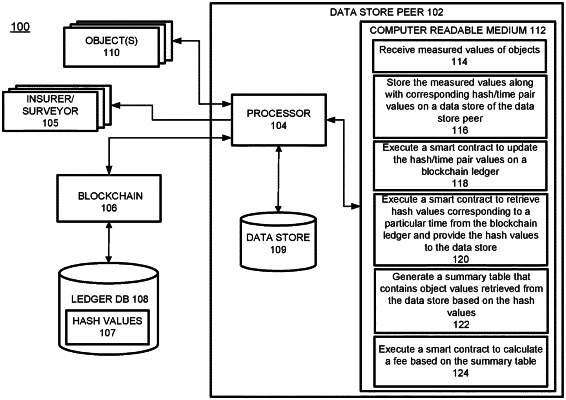| CPC G06Q 20/382 (2013.01) [G06F 16/1805 (2019.01); G06F 16/1834 (2019.01); G06F 16/27 (2019.01); H04L 9/0643 (2013.01); H04L 9/3247 (2013.01); H04L 9/50 (2022.05)] | 6 Claims |

|
1. A peer in a blockchain network, the peer comprising:
a processor that, when executing instructions stored in a memory, is configured to:
receive current measured values of a tangible object from a sensor associated with the tangible object in real time;
generate current hash/time pairs corresponding to the current measured values;
store the current measured values and the corresponding current hash/time pairs in a table of a data store of the peer, where the hashes are hashes of the measured values and the times are timestamps of the measured values;
generate a blockchain transaction that comprises the hash/time pairs corresponding to the current measured values;
execute a blockchain consensus among a plurality of peers of a blockchain ledger to validate the blockchain transaction, wherein the execution of the blockchain consensus includes verifying that a correct allotment of peers specified by an endorsement policy have authenticated the blockchain transaction with signatures;
update, via execution of a smart contract, previous hash/time pairs corresponding to previous measured values, which are previously stored in the blockchain ledger, with the hash/time pairs corresponding to the current measured values in response to a successful blockchain consensus to generate updated hash/time pairs;
retrieve, via execution of a second smart, hash/time pairs corresponding to a particular time and calculation rules from the blockchain ledger;
retrieve measured values from the data store corresponding to the particular time based on the hash/time pairs retrieved from the blockchain ledger;
generate a summary table comprising the retrieved measured values corresponding to the particular time; and
calculate, via execution of a third smart contract, an insurance cost of the tangible object based on the summary table and the calculation rules.
|